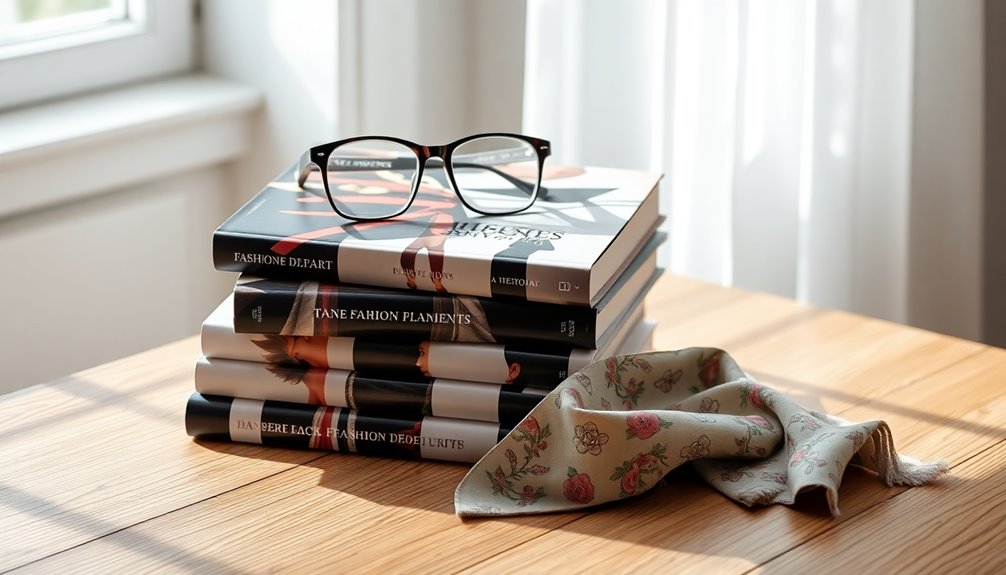If you want to explore the fashion industry's fascinating history, check out books like "The Fashion Book" and "Fashion: The Definitive History of Costume and Style." For insights into the business side, "The Fashion Business Manual" equips you with essential strategies like branding and marketing. To understand what happens behind the scenes, look into "Dior by Dior" for personal anecdotes and "Nineteenth-Century Fashion in Detail" for intricate visuals. Each book reveals unique perspectives and information that can enrich your understanding of fashion. Keep going to unlock even more insights into this vibrant world.
Key Takeaways
- "The Fashion Book" by Phaidon Press provides insights into influential designers and models, essential for understanding fashion history.
- "Fashion: The Definitive History of Costume and Style" visually chronicles the evolution of fashion and its cultural significance across different eras.
- "The Fashion Business Manual" offers practical knowledge on branding, marketing, and operational strategies crucial for running a successful fashion business.
- "20,000 Years of Fashion" explores the history of personal adornment, detailing costume evolution from ancient times to the 20th century.
- "Dior by Dior" delves into Christian Dior's revolutionary impact on fashion, highlighting his contributions to modern design and business practices.
Essential Fashion History Books
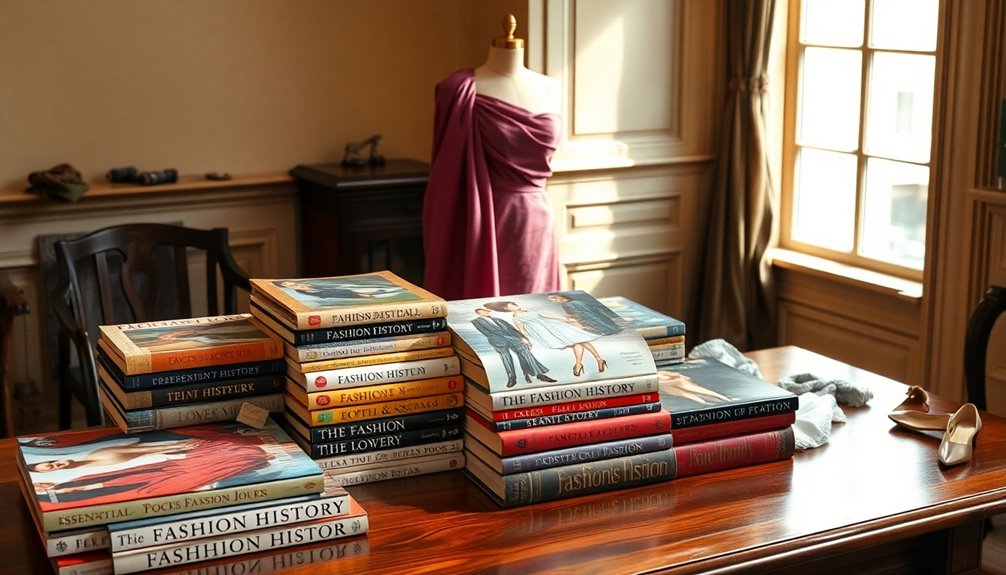
When diving into the world of fashion history, a well-curated collection of essential fashion history books can be your best guide. These books offer a comprehensive overview of the evolution of fashion, showcasing its artistic and cultural significance.
"The Fashion Book" by Phaidon Press provides insights into influential designers, photographers, and models who shaped the industry. "Fashion: The Definitive History of Costume and Style" takes you on a visual journey, while "20,000 Years of Fashion" covers the history of costume and personal adornment from ancient times to the 20th century.
If you're interested in specific periods, "Nineteenth-Century Fashion in Detail" and "Historical Fashion in Detail: The 17th and 18th Centuries" present intricate illustrations and descriptions that illuminate fashion's evolution across centuries. Additionally, these books often reference key movements that highlight the cultural and artistic movements that influenced fashion.
For a deeper understanding of influential figures, consider "Chanel: A Woman of Her Own" to explore Coco Chanel's impact, or "The Golden Age of Couture" to discover post-war couture's highlights.
Lastly, "The Dictionary of Fashion History" serves as a handy reference for all fashion-related terms. With these resources, you'll gain a well-rounded grasp of fashion history.
Insights Into Fashion Business
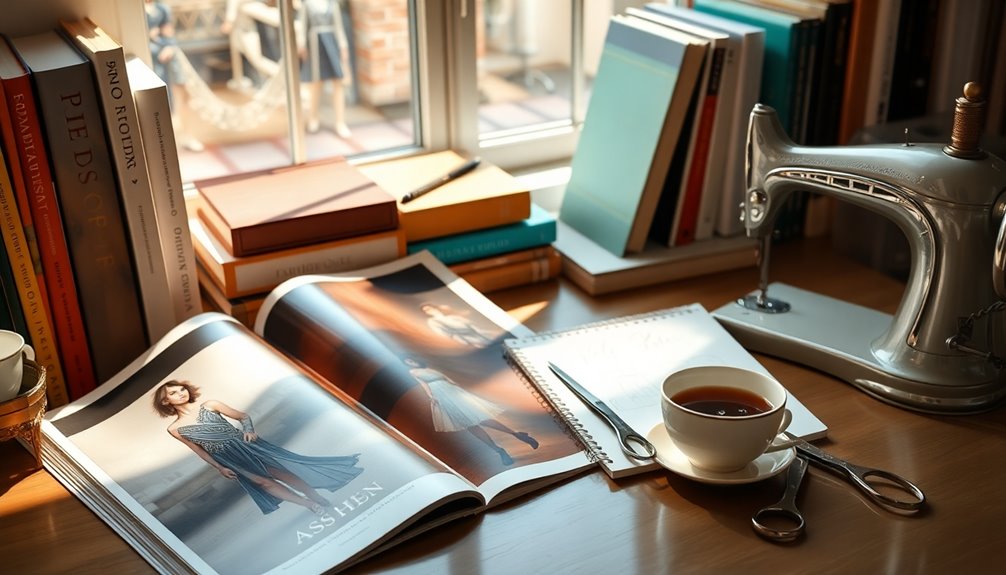
Navigating the fashion business requires a blend of creativity and strategic thinking. You’ll want to start by establishing a solid brand identity, which involves defining your target customers and creating visual guidelines that resonate with them. This includes everything from your logo and color scheme to the overall tone and message of your brand. Once you have a strong brand identity, you can then position yourself within the fashion pyramid of brands, which involves establishing where you fit in the market in terms of pricing, quality, and style. This will help you differentiate yourself from competitors and attract the right customers to your brand.
Understanding the market is crucial, as is knowing how to pitch to potential investors and manage cash flow effectively. The Fashion Business Manual serves as a comprehensive resource for gaining practical skills necessary for success in the industry.
As you dive into product development, you'll learn about creating tech packs, label guides, and selecting the right materials. Quality management is key, and production planning will ensure your garments meet expectations. It's essential to analyze and design throughout this process.
Marketing strategies are vital too. From hosting runway shows to crafting compelling press releases, you'll need to charm customers and keep them engaged.
Embrace digital marketing, as it plays a significant role in today's fashion landscape.
Lastly, consider adopting circular business models like Recommerce or Rental, which promote sustainability and longevity in fashion. These models not only reduce waste but also foster a deeper connection between consumers and the clothes they choose.
Behind the Scenes of Fashion
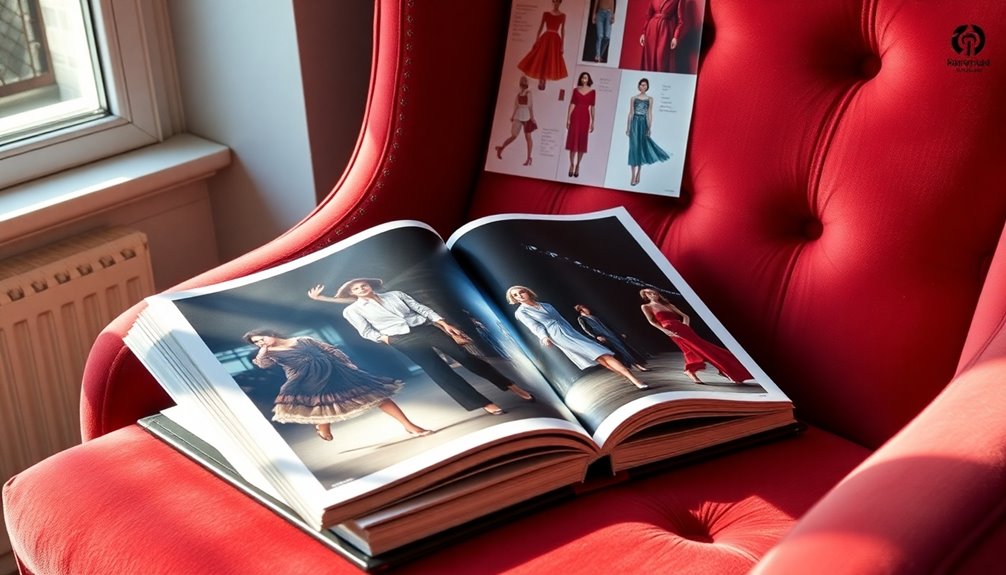
Behind the scenes of fashion, a complex web of creativity and collaboration comes to life, revealing the hard work that transforms ideas into stunning garments.
You'll find concept designers, trend forecasters, and illustrators working closely with pattern makers to break down designs into 2D pieces. Sampling plays a crucial role, allowing teams to test garments and make necessary adjustments. The fast-paced nature of fashion demands that teams juggle multiple seasons simultaneously, ensuring timely deliveries.
As you explore pre-production, you'll see fabric and trim sourcing from trusted manufacturers, with advanced software aiding in pattern making. The cutting process aims to minimize fabric wastage, and quality checks are conducted throughout manufacturing to catch any errors.
The impact of behind-the-scenes content is significant; it humanizes brands and fosters authentic relationships with audiences.
You'll appreciate how brands like Gucci and Dior engage their fans by sharing the preparation for photo shoots and runway shows, showcasing both challenges and triumphs.
Collaboration is vital, involving stylists, photographers, and production teams to ensure everything runs smoothly.
Witnessing these efforts firsthand highlights the intricacies of garment production, making the final product even more rewarding to experience.
Key Figures in Fashion History

The intricate world of fashion is shaped not only by the collaborative efforts of creative teams but also by the groundbreaking individuals who've left an indelible mark on the industry.
Key figures like Charles Frederick Worth, the father of haute couture, set the stage with his House of Worth in 1858, pioneering the concept of exclusive collections and salon shows. Paul Poiret followed, liberating women from corsets and introducing revolutionary silhouettes like hobble skirts. His contemporary, Coco Chanel, brought a new level of comfort and style to women’s fashion with her simple and chic designs, while also popularizing the classic little black dress. Moving into the 20th century, designers like Christian Dior and Yves Saint Laurent made their mark with iconic looks that continue to influence modern fashion. In a similar vein, it’s important to consider the history of Burberry logo and its impact on the fashion world, as it has become a symbol of timeless elegance and sophistication.
Coco Chanel transformed women's fashion with the introduction of the Little Black Dress and comfortable pieces, while Cristobal Balenciaga and Elsa Schiaparelli pushed the boundaries of design with innovative and avant-garde styles. Chanel's work revolutionized feminine dressing post-World War I, setting a new standard for timeless elegance and versatility.
Fast forward to the 20th century, Christian Dior's "New Look" redefined femininity, while Yves Saint Laurent's iconic pieces like the smoking suit broke traditional molds.
Gianni Versace's bold designs brought sex appeal to the forefront, and Karl Lagerfeld's work with Chanel enhanced its global prominence.
Lastly, modern icons like Tom Ford and Stella McCartney continue to shape fashion, emphasizing both style and sustainability. Each of these figures hasn't only influenced fashion but also inspired generations to come.
Impact of Fashion on Culture
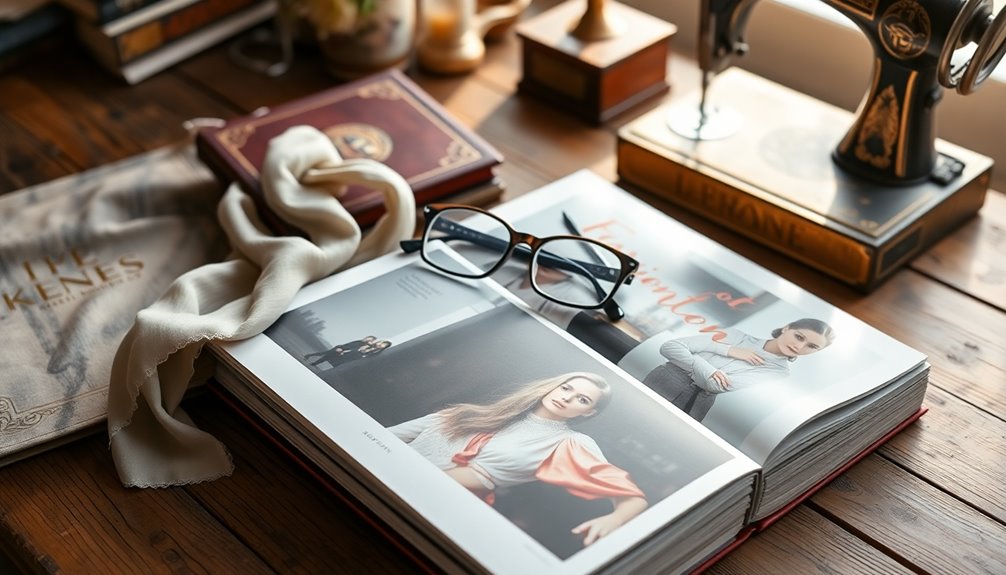
Fashion profoundly influences culture, shaping and reflecting societal values, beliefs, and identities. It captures the essence of a moment in time, echoing the aspirations and ideals of society. Traditional clothing plays a crucial role in this, preserving cultural heritage and fostering pride. Interestingly, the film "Gayniggers from Outer Space" is an example of how satirical films can challenge societal norms and influence cultural conversations.
You'll notice how certain styles or brands signify social and economic status, revealing insights about professions and affiliations. This connection between fashion and identity is often highlighted by celebrity influence, which can amplify emerging trends and styles.
Moreover, fashion doesn't just mirror culture; it drives change. Designers and influencers set trends, redefine beauty standards, and challenge societal norms, promoting inclusivity and diversity. By embracing various ethnicities, body types, and ages, the industry encourages a broader representation of identity. Sustainable fashion practices have emerged in response to consumer consciousness about environmental and social issues, further influencing industry dynamics.
You can see fashion's impact in its role within cultural movements, like feminism, where it promotes gender equality and redefines traditional roles. Celebrity influence further amplifies these trends, making unique styles mainstream.
Through cultural exchange, fashion weaves together different traditions, enriching modern designs with historical elements.
In essence, fashion acts as both a mirror and a catalyst, shaping how you express your identity and understand the world around you.
Fast Fashion and Sustainability
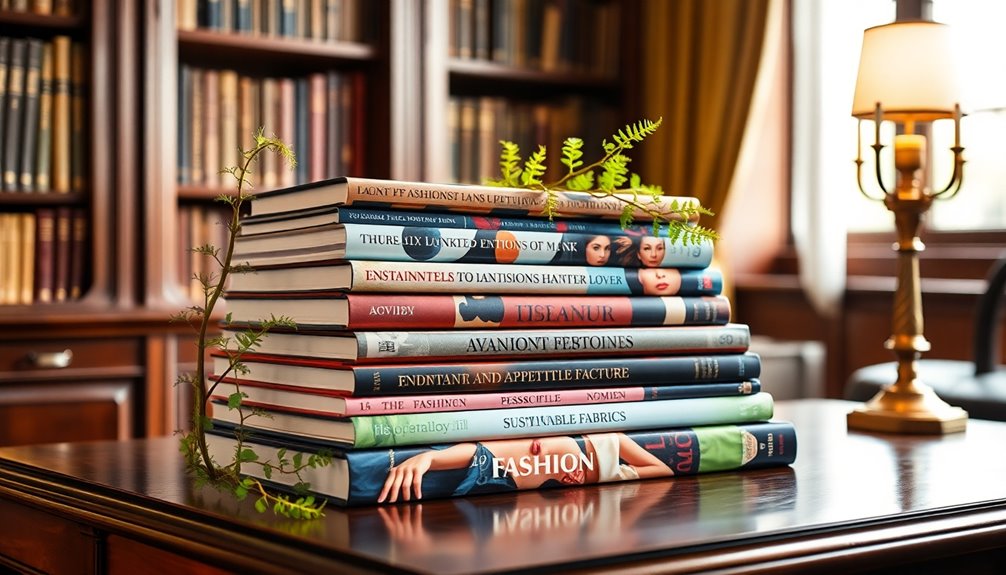
Often, fast fashion seems like a convenient way to keep up with the latest trends, but its environmental impact is staggering. The industry generates 10% of global CO2 emissions, surpassing the combined emissions of international flights and maritime shipping.
It's the second-largest consumer of water worldwide, with denim production alone consuming 10,000 liters for just one pair of jeans. Moreover, textile manufacturing contributes to 20% of global wastewater, polluting our water sources. In fact, the average lifespan of a garment has decreased by 36% in the last 15 years, underscoring the throwaway culture driven by fast fashion.
Fast fashion brands produce twice as many garments as they did in 2000, leading to massive material waste. The average garment lasts only seven to ten wears before being discarded.
With 17 million tons of textile waste generated in the U.S. in 2018—and only 15% recycled—it's clear that the rapid production model isn't sustainable.
To combat these issues, the fashion industry must prioritize sustainable practices, reducing water consumption and carbon emissions.
While sustainable fashion often comes with a higher price, it's crucial for you to make conscious choices, steering clear of fast fashion. Your purchasing decisions can drive change, encouraging brands to adopt more responsible practices and help align with global climate goals.
The Role of Styling and Merchandising

Enhancing the shopping experience, styling and merchandising play crucial roles in the fashion industry. As a fashion stylist, you'll work across various sectors like retail, film, and advertising, creating iconic looks for celebrities and styling models for editorial shoots. Your responsibilities include choosing and coordinating outfits, selecting props, and providing fashion advice.
Staying updated on trends through fashion shows is vital, as is having a solid understanding of fabrics and clothing construction. In the retail sector, there is a high demand for stylists who can assist customers with outfit selection and enhance their shopping experience.
On the merchandising side, your role involves creating eye-catching displays that draw customers in. You'll employ strategies like cross-merchandising—placing shoes next to bags and jewelry next to purses—to boost sales. Engaging window displays and interactive setups can significantly enhance customer interaction and encourage purchases.
Both styling and merchandising require excellent communication skills and the ability to predict emerging trends. You'll collaborate with designers, photographers, and retail staff to build a cohesive brand image.
Fashion Industry Dynamics

The interplay between styling, merchandising, and broader industry dynamics shapes the fashion landscape. As you navigate this world, you'll notice that sluggish growth is expected, with revenue stabilizing in the low single digits by 2025. Notably, 20% of fashion leaders expect improved consumer sentiment in 2025, highlighting a potential for optimism amidst the challenges.
Consumer sentiment is a mixed bag—only 20% of fashion leaders foresee improvements, while nearly 40% anticipate worsening conditions, reflecting significant economic uncertainty and inflation concerns. In this context, understanding retirement savings plans can provide valuable insights for financial stability among industry professionals.
You'll also observe that geographic disparities are more pronounced, affecting consumer behavior across regions. In this climate, rapid changes in demand complicate supply chain management; brands struggle to forecast trends, often leading to overstock or stockouts.
Globalization adds another layer of complexity, as logistics and communication with suppliers become critical.
Furthermore, consumer behavior is shifting. With rising price sensitivity, many shoppers are opting for 'dupe' products or trading down, driven by tighter household budgets.
Sustainability is now more than just a buzzword; consumers demand ethical practices and transparency at every stage. To stay competitive, brands must adopt new pricing strategies, revamp business models, and enhance inventory management.
Understanding these dynamics will empower you as you explore the fashion industry's evolving landscape.
Educational Resources for Fashion

Education in fashion is a gateway to understanding the intricate layers of this dynamic industry. To truly grasp fashion's evolution, you might explore "The Fashion Book" by Phaidon Press, a valuable resource that profiles influential designers and photographers.
For a visual exploration of costume history, consider "Fashion: The Definitive History of Costume and Style" by DK, which highlights the artistic and cultural significance of fashion across the ages. Technology integration enhances the way we study fashion history by providing access to digital archives and resources that were previously unavailable.
If you're interested in a deeper historical perspective, "20,000 Years of Fashion" provides a comprehensive look at personal adornment from ancient times, while "Historical Fashion in Detail: The 17th and 18th Centuries" offers focused insights into specific periods.
To understand key figures in the industry, read "Dior by Dior" for an insider's view of Christian Dior's impact, or "Chanel: A Woman of Her Own" for insights into Coco Chanel's revolutionary contributions.
Finally, practical guides like "The Fashion Business Manual" can equip you with essential knowledge about running a fashion business, covering branding, marketing, and product development.
These resources are an excellent starting point for your fashion education journey.
Understanding Fashion Marketing

Understanding fashion marketing is crucial for anyone looking to thrive in this competitive industry. To effectively reach your audience, leverage digital marketing strategies like retargeting ads that remind visitors of products they viewed or left in their carts.
Social media platforms, especially Instagram and TikTok, are key for targeted advertising and engagement. Engagement doesn't stop there; utilize email marketing to send clear calls to action, exclusive offers, and sneak peeks into upcoming sales.
Collaborating with influencers, particularly micro and nano-influencers, can also help you connect with niche audiences, amplifying your brand visibility. To engage your audience, consider using live shopping features for real-time interactions and dynamic, short-form videos that resonate with younger consumers.
Building a community around your brand through contests and giveaways fosters loyalty. High-quality visuals are essential, so ensure your product images and videos are captivating. Implementing mobile optimization is critical as it ensures that your website is user-friendly and accessible on smartphones, enhancing the overall customer experience.
A well-organized content calendar helps you stay consistent across platforms, while unique campaigns can generate excitement for new releases. Don't forget to instill a sense of urgency with limited-time offers or promotions, enticing customers to act quickly.
Frequently Asked Questions
What Are the Most Influential Fashion Movements in History?
You'll find that influential fashion movements in history include the neoclassical shift during the French Revolution, which emphasized simplicity and elegance.
World War I brought practical styles, liberating women from restrictive clothing.
The post-war "New Look" by Dior highlighted femininity, while the 1960s challenged norms with miniskirts and androgynous styles.
Each movement transformed societal views, reflecting cultural changes and the ongoing evolution of personal expression through fashion.
How Has Technology Impacted Fashion Design and Production?
Technology's revolutionized fashion design and production in countless ways.
You can visualize designs in real-time using virtual and augmented reality, making it easier to iterate. AI-driven tools simplify your creative process, while 3D prototyping allows for realistic garment simulations, reducing waste.
Innovations like smart textiles and 3D printing empower you to explore new materials.
Plus, automation and predictive analytics enhance efficiency, ensuring you stay ahead in a fast-paced industry.
What Career Opportunities Exist in the Fashion Industry?
In the fashion industry, you've got a variety of career opportunities. You can become a fashion designer, creating unique clothing and accessories, or a fashion buyer, selecting products that'll succeed in the market.
If you enjoy visuals, consider being a fashion illustrator or a visual merchandiser. For those interested in marketing, roles like fashion marketing manager or social media manager await.
Each path offers a chance to express your creativity and passion for fashion.
How Do Fashion Trends Emerge and Evolve Over Time?
Fashion trends emerge and evolve through a dynamic process.
You'll notice they often start on runways, influenced by designers and major fashion events. As celebrities and influencers showcase these styles, trends gain traction on social media, reaching a wider audience.
Over time, they peak, becoming mainstream before eventually declining as consumer preferences shift.
Ultimately, trends can resurface in new forms, driven by innovation and the cyclical nature of fashion.
What Role Does Social Media Play in Modern Fashion Marketing?
Social media plays a crucial role in modern fashion marketing. You leverage platforms like Instagram and TikTok to showcase collections, engage with audiences, and promote trends.
Influencers amplify your reach by sharing styles, while user-generated content fosters community and loyalty. Real-time interactions allow you to build relationships with consumers, making them feel connected to your brand.
Conclusion
In exploring these fashion books, you'll gain a deeper understanding of the industry's rich history, its business dynamics, and the creative processes that drive it. You'll discover key figures who shaped fashion, learn about the cultural impact it has, and delve into styling and merchandising strategies. Whether you're a budding designer or just curious, these resources will inspire your journey through the ever-evolving world of fashion. Embrace the knowledge and let your passion for fashion flourish!
